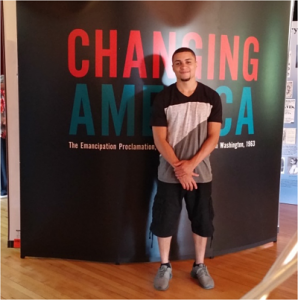
Jordan Henderson ’17 at NAHOF
This post was written by Jordan Henderson ’17
The National Abolition Hall of Fame and Museum (NAHOF), located in Peterboro, NY, honors antislavery abolitionists, their work to end slavery, and the legacy of that struggle, and strives to complete the second and ongoing abolition– the moral conviction to end racism. Members of the museum have been doing great work in their community and the surrounding areas for about a decade now. I have been working directly under Dot Willsey, the former President of the cabinet here at the museum. The main tasks that I have been charged with this summer include hosting the museum on a daily basis, attending a few weekend events, and collecting and analyzing data regarding visitors’ experiences and motivations to commit to the “Second Abolition,” the eradication of racism.
Coming in with little knowledge of 19th century reform movements, I was a little worried that I would struggle in certain aspects of my job that I thought may require this historical knowledge, but I found that not to be the case. So many people come to the museum with little to no knowledge of 19th century reform movements, or even 20th century reform movements. This has been a learning experience for me, and I have come to realize that historical events and individuals from the past tend to get mythologized, and in order to truly learn about our history, we have to make these events and individuals real. I believe that the National Abolition Hall of Fame and Museum has the resources to make this history real in a sense for its visitors; it has for me.
My main project this summer has been to conduct research on visitors’ experiences with an exhibit here at the museum that is on loan from the Smithsonian’s National Museum of African American History and Culture, called Changing America: The Emancipation Proclamation, 1863, and the March on Washington, 1963. One hundred years separate the Emancipation Proclamation and the March on Washington, yet they are profoundly linked together, as both grew out of decades of people demanding justice, resisting, and taking bold actions in the hopes that they would create some sort of lasting change. It is no secret that our nation has a very ugly history of systematic oppression, particularly for black folks, but as a Sociology major who has taken various courses that tackle issues of racism, mass incarceration, and social inequality, I find it very eye opening to be able to make connections between the past and the present. My experience with the Changing America exhibit this summer has allowed me to clearly see how the systems of the past such as slavery and Jim Crow laws are truly the roots to many of our problems today.
I have enjoyed being an Upstate Institute Summer Field School Fellow this summer. I learned a lot about the very region that I grew up in, and I admire that the field school relies on a community-based approach to research.

